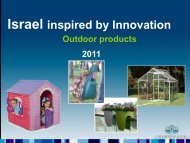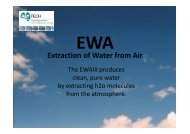PDF file - Israel Trade Commission
PDF file - Israel Trade Commission
PDF file - Israel Trade Commission
Create successful ePaper yourself
Turn your PDF publications into a flip-book with our unique Google optimized e-Paper software.
Agriculture 2011<br />
Developing a High<br />
Spatial and Temporal<br />
Resolution Database for<br />
Meteorological Based<br />
Agronomical Models<br />
Dr. Offer Beeri and Shay Mey-tal<br />
money on soil/plant sensing and sampling. The main<br />
goal of this project was to replace this method of hand<br />
sampling with a computer-based system. To achieve<br />
this goal, satellite imagery was integrated with climate<br />
dataset in a geographic information system (GIS),<br />
allowing for the collection of the data and the processing<br />
of daily reports for field crops in the project.<br />
Figure 1. Noon-time temperature, 28-March-2009, as captured by<br />
climate stations network (A) and satellite imagery (B).<br />
Local meteorology is an important part of agriculture<br />
crop monitoring as correct management incorporates<br />
crop growth and growth rate with weather data in order<br />
to determine irrigation amounts and timing. The most<br />
important climate data for this monitoring are growing<br />
degree-days (GDD) and evapo-transpiration (ET), where<br />
the former represents the accumulated temperature required<br />
for crop growth, and the latter characterizes the<br />
loss of water to the atmosphere. Both are necessary to<br />
ensure that the supplied water amounts are calculated<br />
based on the current growth rate and the loss of water.<br />
Most farmers are dependent upon climate stations<br />
located 30-50 km (20-30 miles) from each other (Figure<br />
1A). With local changes in topography, soil and drainage,<br />
the huge spatial variability between each pair of stations<br />
does not allow for effective monitoring of local crop<br />
fields (Figure 1B).<br />
As a result, farmers invest large amounts of time and<br />
5<br />
Scientific background:<br />
The main method to determine the amounts of water<br />
during any crop irrigation is calculating the potential<br />
ET, multiplied by crop coefficients that are based on<br />
crop growing models. These variables are calculated<br />
from weather stations and known experimental data to<br />
represent the day-to-day changes. Yet, as the spatial<br />
distribution is greater than the average field size, local<br />
differences are not recognizable. Numerous researchers<br />
have attempted to resolve this issue by integrating<br />
remote imagery. These projects have illustrated that as<br />
crops become dryer and require more water, the greater<br />
the difference between crop and air temperatures<br />
(Moran, 1994). To ensure that crop growth stages do<br />
not affect this model, the vegetation temperature is<br />
normalized by the vegetation vigor, both mapped by<br />
satellite imagery. This index represents the vegetation<br />
resistance to transpiration (Nemani and Running, 1989)<br />
with higher values indicating water-stress. Integration<br />
of this method will allow for the mapping of differences<br />
between neighboring crop fields, as well as inside<br />
any plot, and agriculture growth models that use crop<br />
coefficients for monitoring will enable updated irrigation<br />
amounts for each field.<br />
30
















